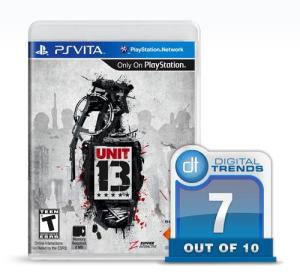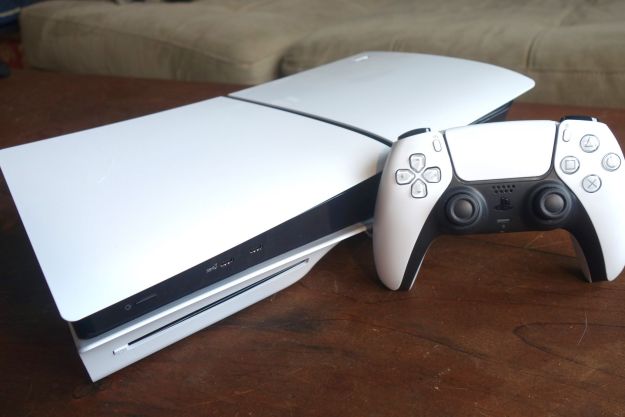It is somewhat impressive that despite any real sense of immersion, despite a broken AI, despite iffy graphics and a temperamental online side, Unit 13 is still an entertaining game. Most of the time.
Unit 13 is an interesting game for what it is. It is a third person shooter for people that don’t want to be bogged down by pesky little things like story and character development. That can make it hard to connect with, but it also trims the fat and gets right to the heart of the matter. Whether or not you like that approach will boil down to a matter of taste, but the story-ectomy makes all the flaws in the flaws in the game all the more obvious.
Yours is not to reason why…
If you have played Zipper Interactive’s SOCOM series, then you know a bit of what to expect, at least in terms of the combat. The game is based on cover and third-person shooter tactics. Each mission presents you with an objective (or a series of objectives), you select your character, then sally forth to massacre a small army that had the misfortune of being on duty and standing between your and goal.
The bulk of the game revolves around the solo missions. There are 36 to unlock, and once they are open, you can approach them two ways: ranked or dynamic. Ranked missions earn up to five stars, which you accumulate and use to unlock another mission type known as “High Value Targets.” These are challenging missions that send you through levels you may have already seen, and task you with eliminating a target waiting at the end. The High Value missions aren’t easy to unlock, and you shouldn’t be surprised to find yourself deep into the game before more than the first few are open.
The second mission types are the dynamic missions, which can be chosen as an alternative to the ranked missions, but are best played after completing the ranked option. You don’t earn stars, and the spawn point and objectives are random–as is the difficulty level–which all results in making a familiar level seem fresh.
Regardless of what mission you select, you are given the choice of one of six characters, each with their own specialty. The missions are broken into several types, from stealth to timed missions, to sniper-based assassinations to run and gun to name a few. For each mission, there will be one character that is best suited–although you have the freedom to choose any of the six. They all have a stat breakdown which is displayed during the selection screen, and some have low health but high stealth, or high speed but low ammo–each character has pros and cons.

Each character can also be upgraded, and this is when the game really picks up as each character unlocks abilities that all the characters can use. For example, using the stealth character enough will eventually unlock suppressors for all the characters, which then makes it easier to level up others that may not be your favorite.
The game play is built around cover mechanics and standard aiming features. Both analog sticks function as would with a standard controller, and you can sprint, take cover, and melee as you might expect.
Unit 13 also integrates Vita’s touchscreen as well as any Vita game out there. Too many titles try to shoehorn it into the game and end up hurting the overall package. Unit 13, however, uses the touchscreen well. The weapon icon on the screen acts as a reload button, and while you are aiming, you can hit an icon to change the view to a scope. Hitting the HUD brings up a larger map, which shows you the immediate area. When interactive objects appear, you can hit the prompt to use it, including things like hurtling cover. And that’s it. It is functional and smooth, and works well. Most importantly, it adds to the game without making you engage in actions that are awkward and forced.
One odd gameplay element is the melee attack which works sometimes, except when you really need it to. If you sneak up on someone you can use the melee to take them out without a problem. If you run up to them though, you will often whiff, which will almost always lead to your death.
The end comes to us all
Speaking of, this game can be frustrating, especially in the early going. There is an inconsistent feel to the damage you take that goes beyond the different characters’ health. Sometimes you can take a shot or two, other times it is instant death. It can be frustrating, and it also means that many of the missions will require you to memorize the level and where the enemies are in order to survive.
And speaking of frustrating, the enemy AI is at times an exercise in ridiculous. Generally they can be decent, but now and then you can shoot one in front of another, hide for 30 seconds, and they will forget you are there. On other occasions they will run right past you and aim in the wrong direction as you stand next to them. At one point I exchanged fire with an enemy at the end of the hall, then fell back past a door. Another enemy emerged from that door, and pointed at the enemy I was firing on. For a brief insane moment, it appeared as if the enemies were firing on each other. It was gloriously silly.

This level of inconsistent AI can make missions incredibly hard, or ridiculously easy. Each room is a fresh slate and enemies won’t recognize what happened before you enter that new room, even if you are seconds removed from causing a dozen mines to explode. You never know what you are going to get. In a game that has nothing but the missions, a faulty AI is problematic.
The graphics are also more akin to the PSP than the Vita, but that is a minor issue–they are serviceable.
If you wish, you can pair up with a buddy via the co-op and tackle missions as a pair. There are some connectivity issues that have plagued the launch, but hopefully those are apparitions and not the norm. When it works, it is fun. So far that has been rare though, and it is more common to receive an error than to remain connected online. The lack of ad hoc multiplayer is also perplexing, as it seems like an obvious inclusion.
Along with the co-op is also a daily challenge, which pits your times against those around the world. Another good inclusion, but again, limited by connectivity issues.
Conclusion
The gameplay in Unit 13 is generally solid, but the problems with the AI hurt, and the lack of a story make the errors all the more pronounced. When it all works, Unit 13 is a strong third-person shooter that is a blast to play, but when it doesn’t, it can be undeniably frustrating.
Hopefully the online problems are just a fluke, because the co-op is a good way to go. The single player is where you will spend the majority of your time, but the co-op is what most people will probably be attracted to, and rightly so. It’s just a shame that there is no ad hoc to fall back on when you and your friends are in the same area, and its omission makes no sense.
Even with the problems, if you are absolutely dying to play a shooter on the Vita, you can do worse than Unit 13. Just be prepared to overlook some frustrating issues.
Score 7 out of 10
(This game was reviewed on the PlayStation Vita on a copy provided by Sony Computer Entertainment)
Editors' Recommendations
- All upcoming PS5 games: 2024 and beyond
- PS4 vs. PS5: which console should you buy in 2024?
- How to transfer data from your PS4 to PS5
- The best PS5 games for 2024
- How to use an external hard drive on PS5



